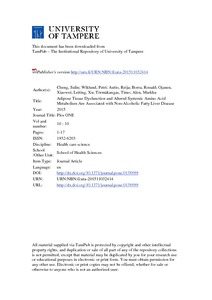Adipose Tissue Dysfunction and Altered Systemic Amino Acid Metabolism Are Associated with Non-Alcoholic Fatty Liver Disease
Cheng, Sulin; Wiklund, Petri; Autio, Reija; Borra, Ronald; Ojanen, Xiaowei; Leiting, Xu; Törmäkangas, Timo; Alen, Markku (2015)
Cheng, Sulin
Wiklund, Petri
Autio, Reija
Borra, Ronald
Ojanen, Xiaowei
Leiting, Xu
Törmäkangas, Timo
Alen, Markku
2015
Plos ONE 10 10
1-17
Terveystieteiden yksikkö - School of Health Sciences
This publication is copyrighted. You may download, display and print it for Your own personal use. Commercial use is prohibited.
Julkaisun pysyvä osoite on
https://urn.fi/URN:NBN:fi:uta-201511032414
https://urn.fi/URN:NBN:fi:uta-201511032414
Kuvaus
Public Library of Science open access
Tiivistelmä
Background
Fatty liver is a major cause of obesity-related morbidity and mortality. The aim of this study was to identify early metabolic alterations associated with liver fat accumulation in 50- to 55-year-old men (n = 49) and women (n = 52) with and without NAFLD.
Methods
Hepatic fat content was measured using proton magnetic resonance spectroscopy (1H MRS). Serum samples were analyzed using a nuclear magnetic resonance (NMR) metabolomics platform. Global gene expression profiles of adipose tissues and skeletal muscle were analyzed using Affymetrix microarrays and quantitative PCR. Muscle protein expression was analyzed by Western blot.
Results
Increased branched-chain amino acid (BCAA), aromatic amino acid (AAA) and orosomucoid were associated with liver fat accumulation already in its early stage, independent of sex, obesity or insulin resistance (p<0.05 for all). Significant down-regulation of BCAA catabolism and fatty acid and energy metabolism was observed in the adipose tissue of the NAFLD group (p<0.001for all), whereas no aberrant gene expression in the skeletal muscle was found. Reduced BCAA catabolic activity was inversely associated with serum BCAA and liver fat content (p<0.05 for all).
Conclusions
Liver fat accumulation, already in its early stage, is associated with increased serum branched-chain and aromatic amino acids. The observed associations of decreased BCAA catabolism activity, mitochondrial energy metabolism and serum BCAA concentration with liver fat content suggest that adipose tissue dysfunction may have a key role in the systemic nature of NAFLD pathogenesis.
Fatty liver is a major cause of obesity-related morbidity and mortality. The aim of this study was to identify early metabolic alterations associated with liver fat accumulation in 50- to 55-year-old men (n = 49) and women (n = 52) with and without NAFLD.
Methods
Hepatic fat content was measured using proton magnetic resonance spectroscopy (1H MRS). Serum samples were analyzed using a nuclear magnetic resonance (NMR) metabolomics platform. Global gene expression profiles of adipose tissues and skeletal muscle were analyzed using Affymetrix microarrays and quantitative PCR. Muscle protein expression was analyzed by Western blot.
Results
Increased branched-chain amino acid (BCAA), aromatic amino acid (AAA) and orosomucoid were associated with liver fat accumulation already in its early stage, independent of sex, obesity or insulin resistance (p<0.05 for all). Significant down-regulation of BCAA catabolism and fatty acid and energy metabolism was observed in the adipose tissue of the NAFLD group (p<0.001for all), whereas no aberrant gene expression in the skeletal muscle was found. Reduced BCAA catabolic activity was inversely associated with serum BCAA and liver fat content (p<0.05 for all).
Conclusions
Liver fat accumulation, already in its early stage, is associated with increased serum branched-chain and aromatic amino acids. The observed associations of decreased BCAA catabolism activity, mitochondrial energy metabolism and serum BCAA concentration with liver fat content suggest that adipose tissue dysfunction may have a key role in the systemic nature of NAFLD pathogenesis.
Kokoelmat
- Artikkelit [6140]
